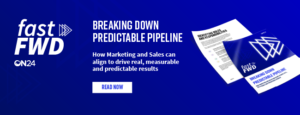How to Use Webinars to Boost MQLs

This post is the latest in our series on B2B marketing optimization and how to take your marketing efforts to the next level.
Identify, qualify and deliver the leads sales actually want. Learn how in this on-demand webinar. [Watch Now]
In our previous post, we covered how you can optimize webinar attendance for lead acquisition.
MQL leads are essential for your business. MQL stands for marketing qualified lead. However, mql lead generation is not easy to come by.
But just because someone attended a webinar doesn’t make them a marketing-qualified lead (MQL) ready to be handed over to sales. We should also note that the pursuit of MQL leads shouldn’t cause you to lose sight of optimizing for the entire customer journey.
Even so, MQL leads are a common metric for marketers, and there are at least two key ways that you can use webinars to turn attendees into MQLs if that’s a goal for your optimization efforts:
-
- You can optimize your data collection to better identify those ready to have a conversation and who would be a good fit for your company’s offerings.
- You can optimize how you engage your attendees to progress and nurture their buying journey, as measured by an increased lead score.
Here are the steps you should take to gain MQL lead generation.
Identify what makes up an MQL
Take a look at your lead scoring criteria to find out what the indicators of MQL leads are for your team and company. Deciding these criteria should be a collaborative effort between sales and marketing to ensure a high likelihood of any leads being accepted (a topic of a future post).
Typically your lead score will be broken into two elements:
- Personal attributes – these might include elements such as seniority or job title, firmographic criteria (e.g., company headcount, company revenues) and details related to BANT (i.e., budget, authority, need and time). It might also include technographic criteria (i.e., the technologies they use that indicate a good fit for your offerings).
- Behavioral attributes – these will represent the behaviors you are looking for to demonstrate progression along the buying journey. For example, you might assign points to viewing certain pieces of content, a separate score for webinar registration and another one based on attendance and/or engagement.
Make sure your webinar platform can send data to your lead scoring system
Chances are your lead scoring happens within your marketing automation platform, although in some instances, data may go to your CRM first. Either way, make sure your webinar platform is connected to your martech/sales stack, that the key data fields are mapped and you can trigger updates to your lead scoring. While you might be able to export data manually from your webinar to upload afterward, this will add time to your process that can reduce the overall impact of your efforts. Here, ON24 Connect can help and save you time.
The data fields you choose should align with the areas that impact lead score. If you’re just getting started with using webinars for lead scoring, it might be easier to only use a small number of fields to test how everything works before adding additional elements later.
At the very least, make sure you can send registration and attended status (i.e., attendee or no-show) to your platform, along with any other key fields in your registration page.
Over time, you might wish to include more data fields. For example, ON24 calculates a number of values across several webinars for its Prospect Engagement Profile, which can be pushed to your own systems.
Set up your webinars to collect data
There are two ways you can collect the data you need:
- At registration. Consider the information you want to collect, but remember that asking too much may impact the performance on the landing page.
- During the webinar. As your attendees tune in, their engagement can be measured to provide the behavioral data points you need to impact their lead score and raise them to MQL level. In addition, polls and surveys create a great opportunity to collect data manually if you need them or chose to not include those fields at registration.
Engage your attendees to drive behavior – and lift your lead scores
Attendance is half the battle. If you don’t provide an engaging session you will miss both the opportunity to create a great experience and the chance to drive actions that will impact lead scores.
ON24’s Webinar Best Practices series has a lot of tips on how to drive engagement, but a few ideas include:
- Deliver calls-to-action to download resources and assets, sign up for free trials or request a demo.
- Run polls and surveys to collect data. If you want people to stay tuned for longer, don’t share the results straight away – instead, deliver them later in the session.
- Encourage sign-ups for future events and on-demand webinars.
- Tell the audience to submit questions either during the webinar, before or both.
All of these engagements can help attendees progress in their buyer journey and provide data to lift your lead scores.
Make best use of your on-demand webinars
There are still opportunities to look for to drive additional MQL leads once your webinar is over. Our post on How to Market Your Webinar After It’s Finished provides detail on the steps you can take to drive additional registrations and engagement.
All great webinars have a long shelf-life, meaning that you can promote them on an ongoing basis. Consider adding them to a content syndication platform such as NetLine, which can also be connected directly to your marketing automation and lead scoring system.
Assess the results and look for opportunities to optimize
Once you’ve run a few webinars and collected some data, you’ll have a benchmark to work against. Look at where you can improve your efforts and set yourself optimization goals to achieve them.
To save you time, you can refresh your existing webinars with optimization in mind, rather than planning them all from scratch.
To find out how you can have your webinar data within your CRM and marketing automation systems, gain MQL lead generation, check out ON24 Connect to help you streamline and automate your optimization efforts.
